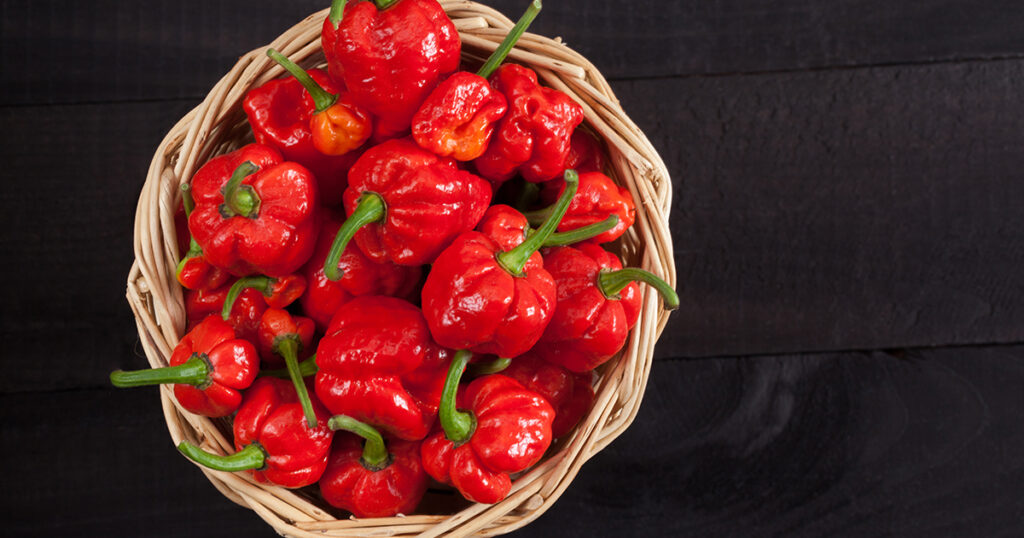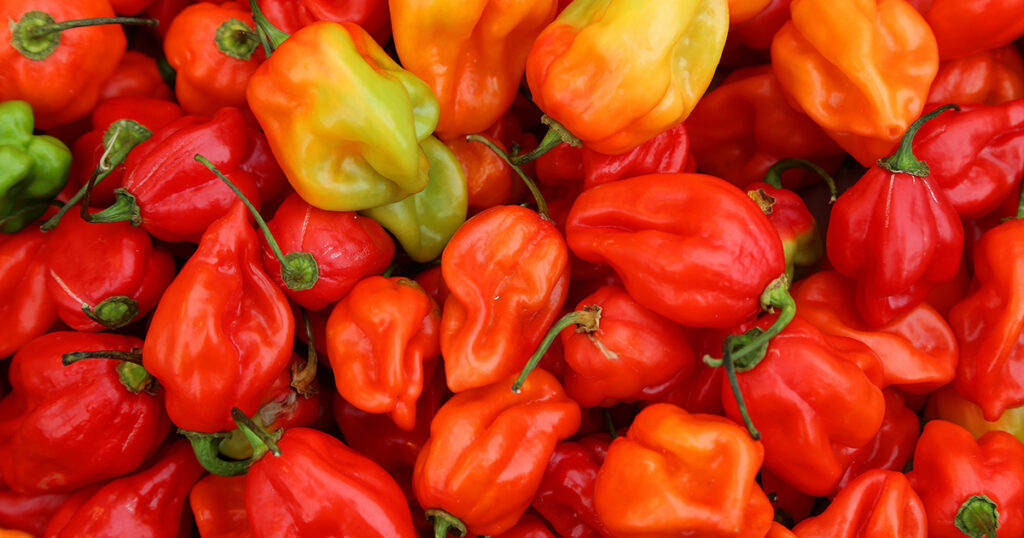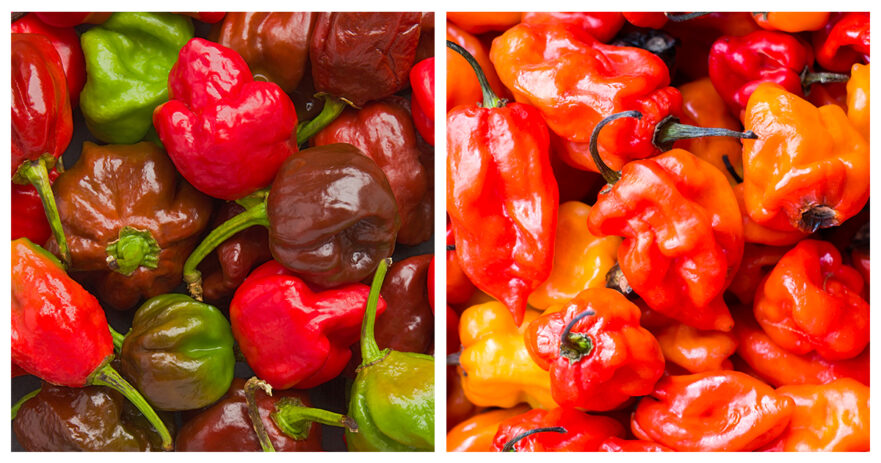Navigating the vibrant world of chili peppers, the Scorpion pepper and habanero stand out as iconic representatives of the Capsicum genus. Both have carved a niche in the spicy food community due to their unmistakable heat levels and flavor profiles. While they might be united in their mission to elevate dishes with a fiery punch, each pepper has its own story and characteristics.
This guide delves deep into the heart of the hottest peppers in the world, demystifying the distinct attributes of these renowned chilies. Whether crafting a bold Caribbean dish, experimenting with hot sauces, or simply curious about these two chili giants, this article provides a flavorful journey into the essence of the Scorpion pepper and habanero.
Table of contents
What is Scorpion Pepper?

The Trinidad Scorpion pepper, often simply referred to as the Scorpion pepper, stands tall in the array of hot peppers. Originating from Trinidad and Tobago, this chili pepper has etched its name among the hottest peppers in the world due to its blazing intensity, combined with rich, fruity flavors.
Its appearance might deceive the uninitiated; the Scorpion pepper hides its ferocity behind a contorted exterior. When rated on the Scoville scale, it touches an alarming 1.2 million to 2 million Scoville Heat Units (SHU), marking its territory among the planet’s spiciest contenders.
Despite the searing heat, the Scorpion pepper has a distinct sweet undertone reminiscent of its Caribbean origin. This extreme heat and flavor mix has captivated hot pepper enthusiasts, making it a sought-after choice for spicy foods and hot sauces.
However, the pepper’s potency isn’t to be underestimated. Handling it carefully, using gloves, and ensuring cleanliness to prevent fiery mishaps is essential.
What is Habanero?

The habanero, a stalwart in the world of chili peppers, is well-acquainted with those who adore spicy food. Tracing its lineage back to the Amazon basin, the journey of this pepper has seen it become a staple, especially in Mexico.
Characterized by its lantern shape and vibrant color palette, from oranges to reds and even chocolate hues, the habanero is both a visual and flavorful treat. On the Scoville scale, it stands with a heat range of 100,000 to 350,000 SHU, ensuring its place in the league of hot peppers.
But the habanero is not just about the heat. Its flavor profile is a harmonious blend of fruity and floral notes, making it an essential ingredient in hot sauces, salsas, and other spicy foods. Its adaptability has cemented its presence across cuisines, from Caribbean delicacies to modern fusion dishes.
As with most hot chili peppers, caution is best when incorporating habaneros into dishes. Their intense spiciness can easily dominate, so moderation and careful measurement are key.
What are the Similarities between Scorpion Pepper and Habanero?
In the universe of spicy culinary delights, the Scorpion pepper and habanero shine as quintessential hot peppers often hailed as some of the hottest peppers in the world. Both chili varieties are from the prestigious Capsicum genus, carrying tales of Central and South American traditions. Their legacy isn’t just about historical significance; today, they’re culinary trendsetters, transforming ordinary dishes into extraordinary spicy feasts.
The fiery inferno they introduce is at the core of their appeal. Revered for their ability to elevate a dish’s heat index, both peppers offer a scorching journey that spice aficionados treasure. Whether it’s a main course taking center stage at a festive gathering or a complementary side dish, these peppers are behind many memorable spicy foods.
Venturing into the world of artisanal hot sauces, you’ll find the Scorpion pepper and habanero making their presence felt. Their robust, fiery profiles make them the go-to for concocting gourmet spicy blends that combine flavor and heat. From casual diners seeking an extra hot kick to gourmet chefs crafting nuanced flavors, these peppers are essential.
Yet, with the intense heat comes great responsibility. Thanks to their capsaicin-rich content, these peppers are not just about flavor but also the experience. The burning sensation, endorphin rush, and lingering afterglow are all part of the package, making them a cherished ingredient for those who truly appreciate the world of spiciness.
What are the Differences Between Scorpion Pepper and Habanero?
While both the Scorpion pepper and habanero are treasured in the chili pepper family, they have distinct traits. On the Scoville scale, the benchmark for measuring spiciness, the Scorpion pepper often stands out. This pepper can reach up to 2 million Scoville Heat Units (SHU), making it one of the world’s hottest peppers. In contrast, the habanero, though fiery, typically ranges between 100,000 to 350,000 SHU.
Flavor profiles also set these two apart. The habanero offers a blend of heat and fruity undertones, presenting a citrusy warmth. The Scorpion pepper, however, delivers a more intense, piercing heat, complemented by a slightly sweet and fruity flavor. This makes the Scorpion pepper a favorite for those seeking extreme spiciness without compromising taste.
Visually, these peppers differ in heat intensity and appearance. The Scorpion pepper, recognized by its unique tail resembling a scorpion’s stinger, is typically a deep fiery red or bright yellow, symbolizing its extreme heat. With its rounded shape, the habanero showcases a palette of colors from bright orange to deep red and unique shades like chocolate or white.
Regarding global culinary influence, the habanero has a broader history, especially in dishes from the Yucatan Peninsula and the Caribbean. With its Trinidadian roots, the Scorpion pepper is gaining traction, especially among those craving the ultimate spicy food challenge in their dishes or hot sauces.
FAQ about scorpion pepper and habanero
Are Scorpion peppers hotter than habanero?
Certainly! The Scorpion pepper is notably hotter than the habanero. While habaneros can reach up to 350,000 Scoville Heat Units (SHU), Scorpion peppers often range between 1.2 million to 2 million SHU, placing them among the world's spiciest peppers.
Is a Scorpion pepper a habanero?
No, a Scorpion pepper and a habanero are distinct chili varieties. Both belong to the Capsicum genus and are celebrated for their intense heat. Still, they have different shapes, flavors, and heat levels. The Scorpion pepper, especially the Trinidad Moruga Scorpion variant, is one of the hottest chilies available.
How spicy is the Scorpion pepper?
The Scorpion pepper is renowned for its extreme spiciness. Rated on the Scoville scale, it can achieve heat levels ranging from 1.2 million to 2 million SHU. This intensity puts the Scorpion pepper among the most potent chilies globally, offering a profound burning sensation that can last for hours.
What pepper is hotter than a habanero?
Several peppers surpass the habanero in terms of heat. The Scorpion pepper is a prime example, with its staggering 1.2 to 2 million SHU. Other peppers hotter than the habanero include the Carolina Reaper, Ghost pepper (Bhut Jolokia), and the 7 Pot Douglah. These chilies are renowned in the spice community for their intense heat.
Is 8000 Scoville hot?
A rating of 8000 SHU on the Scoville scale denotes a moderate level of heat, especially when compared to giants like the Scorpion pepper and the Carolina Reaper, the latter of which holds a place in the Guinness World Records as one of the hottest peppers. To put it in perspective, jalapeños range from 2,500 to 8,000 SHU. While it's spicy for many, it's considerably milder than many other popular chili peppers.

